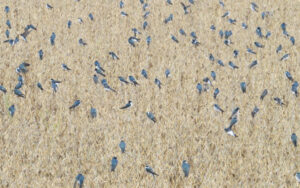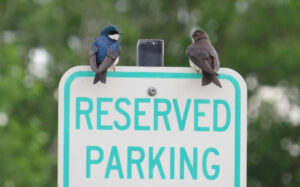Tree Swallow, Tachycineta bicolor
Bill Rowe
In these first weeks of spring migration, with some birds beginning to filter back to us from farther south, we are likely to see some Tree Swallows in the vanguard, among the earliest of our small birds to return. It’s also one of the classiest; its scientific name bicolor really fits, and it could simply be called the Blue-and-white Swallow if that were not already the name of another species south of the border. Its English name refers to its nesting preference, i.e., tree cavities, from dead trunks in a midwestern lake to woodpecker holes in a Rocky Mountain aspen grove. Those nests will most likely be located somewhere near open country, and typically near bodies of water, over which the swallows skim in their never-ending search for flying insects. As with a few other birds, such as bluebirds, their reliance on tree holes translates readily into an acceptance of human-bult nest boxes, giving us the chance to watch them at closer range than usual. In the fall, Tree Swallows may be seen migrating south in sometimes immense numbers, as on certain October days when they seem to carpet the surface of a large river or lake, and trying to estimate how many thousands to enter on your list will give you a headache. The swallow family Hirundinidae is a distinctive group the world over, found on all continents with the usual exception of Antarctica. The Tree Swallow is strictly American, nesting in Canada and the upper and middle U.S. and wintering from our southern coasts down to Panama.
IDENTIFICATION: Swallows can be tough to identify, since you often see them up in the sky, and a cloudy gray background doesn’t help. But a good view lower down, or perched on a wire, will usually make it easy to discern the iridescent blue upperparts and entirely white underparts of the Tree Swallow, both male and female (though females vary and may be partly brown above). Young birds, however, are all gray-brown above and are a bit less obvious, closer to the brown Bank Swallow and Northern Rough-winged Swallow that are also common here; but the young Tree always has a clean white throat and only a hint of a grayish breast-band (see your field guide).
ST. LOUIS STATUS: An early-arriving spring migrant, here already at this writing, and a fairly common nesting bird, mostly near rivers, lakes, and marshes. Its fall migration schedule runs somewhat later than our other five regular swallows, and exceptionally a Tree Swallow may linger into the winter.
Learn more and listen to the calls of Tree Swallows here.
Male and female
(or immature of either sex)
Photo Credit: Bill

Flock in grass near pond, October
Photo Credit: Bill Rowe





